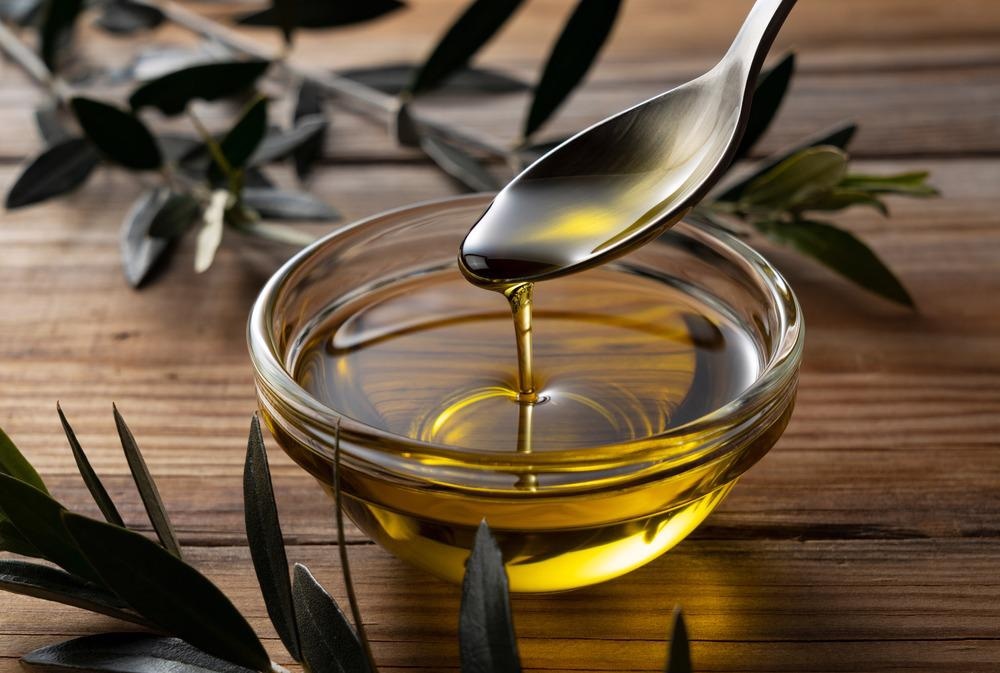The study of olive oil's physical and chemical characteristics is carried out in labs with chemicals, which is expensive and time-consuming. Near-infrared spectroscopy stands out among the different options for measuring olive oil quality characteristics.

Image Credit: masa44/Shutterstock.com
Olive Oil Quality
The highest grade of olive oil is extra virgin olive oil that must be extracted or pressed mechanically at a temperature below 27 degrees Celsius from healthy and fresh fruits. This high olive oil quality has a peroxide index that must be no more than 20 meq/kg. The natural acidity (the quantity of free fatty acids measured as a proportion of oleic acid) must not be above 0.8%.
Virgin olive oil is of a lower quality (VOO). The natural acidity must not exceed 2%. Several factors may contribute to increased acidity. The olive oil quality is not as high because the fruits may not be as healthy as they might have been, or even the extra virgin olive oil may well have expired or been exposed to light or open-air between harvesting and grinding.
The fragrance and taste of virgin olive oil will be slightly off. This is why, in the mixture with Refined Olive Oil, this kind of olive oil is the preferred option for creating industrial "aromatic" olive oils enriched with spices and herbs. Olive oil is notorious for absorbing external odors, both pleasant and foul.
Regarding the variety of olive oils, the most known is VOO. After VOO or virgin olive oils, there is ordinary virgin olive oil and lampante virgin olive oil. The lampante virgin olive oil must be processed before use.
Near-Infrared Spectroscopy
Similar to Raman spectroscopy, near-infrared spectroscopy (NIRS) is vibrational spectroscopy. A molecule absorbs near-infrared radiation when the energy of the radiation matches the energy differences between the two vibrational modes and a transformation occurs in the particle's dipole moment. This is comparable to the mid-infrared range.
The absorption peaks and bands inside the near-infrared spectrum are broad and weak. It also makes near-infrared spectroscopy better for measuring the amount of a substance than identifying it. Near-infrared spectroscopy can also provide valuable data on functional groups.
NIRS is an effective analytical method for quickly, cost-effectively, and non-destructively figuring out what compounds and parameters are in food. Since NIR spectroscopy does not need reagents or create waste, it makes for a safe place to work and has a lot of potential for measuring things online.
Near-Infrared Spectroscopy Spectrum of Olive Oils
During sample preparation, the temperature of the sample has a significant effect on how much near-infrared radiation it absorbs and reflects. This makes temperature one of the most critical parameters in NIR spectra.
Most of the time, olive oil analysis uses a temperature of around 32 °C. At this temperature, the condition of olive oil is a liquid, and some volatile compounds are lost.
Preparing a sample for near-infrared spectroscopy involves heating olive oil and keeping it at a consistent temperature while the spectrum is being taken. On the other side, NIR radiation goes deeper into organic specimens than visible, UV, and other infrared radiations (mid and far-infrared).
Result of NIRS Usage on Selecting Olive Oil Quality
Information in the literature shows that near-infrared spectroscopy could be used to study olive oil, similarly to how it has been used to analyze the quality of olive and olive paste. Near-infrared spectroscopy equipment is commercially available to measure some of the most critical parameters.
In olive oil mills or bottling plants, there is a sample preparation system for olive oils and near-infrared spectroscopy equipment for getting their NIR spectra. This would allow the primary quality parameters of the olive oils to be determined on-site.
Health Benefits of Olive Oils
Antioxidants, chemicals that help us fight inflammatory and chronic illness, are abundant in extra virgin olive oil.
Extra virgin olive oil is high in monounsaturated fatty acids, a healthy fat related to several health advantages and its excellent antioxidant concentration.
Monounsaturated fatty acids (MUFAs), in particular, is anti-inflammatory and beneficial to heart health. Olive oil has the highest proportion of monounsaturated fat compared with other cooking oils.
Further Development of Near-Infrared Spectroscopy in Olive Oil Analysis
The NIRS machinery at olive oil processing facilities should be equipped with self-learning calibration systems to enhance the outcomes. The system can check olive oil quality with samples from fresh harvestings, various designations, geographical areas, and variations.
The final aim is to gain acceptance of NIR spectroscopy as an official method for detecting the olive oil quality parameters and the dietary parameters by the noteworthy national authorities and, as a primary concern, the International Olive Council.
References and Further Readings
Martin, J. (2022). Potential of Near-Infrared Spectroscopy for the Determination of Olive Oil Quality. Sensors. https://doi.org/10.3390/s22082831
Disclaimer: The views expressed here are those of the author expressed in their private capacity and do not necessarily represent the views of AZoM.com Limited T/A AZoNetwork the owner and operator of this website. This disclaimer forms part of the Terms and conditions of use of this website.